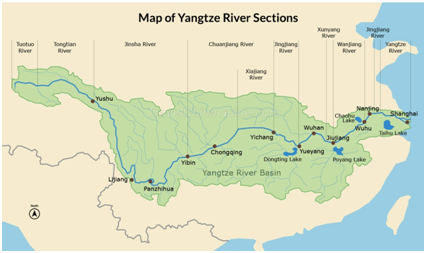China operationalises world's second-largest hydropower dam
-
Context
China officially began operating the first two generating units of Baihetan, world's second-largest hydropower station.
-
Background
- Baihetan is one of the four Chinese hydropower projects either in operation or under development with an installed capacity of more than 10GW.
- The four projects, all located on the Jinsha River, will have a combined installed capacity of approximately 46GW and an annual generation capacity of 190TWh.
- The other three mega hydroelectric projects apart from Baihetan are:
- the 22.5GW Three Gorges Dam (operational) on the Yangtze River
- the 13.86GW Xiluodu hydropower station (operational)
- the 10.2GW Wudongde hydropower station (under construction) on the Jinsha River
- The Baihetan and Wudongde projects are envisioned under the Go-West Program of China, which is aimed at transferring electricity from west to east China.
- The Baihetan project is located downstream of the Wudongde hydropower project. The Xiluodu and the 6.4GW Xiangjiaba hydroelectric projects located downstream of the Baihetan project have been operational since 2013 and 2012, respectively.
-
Analysis
What is Baihetan Dam?
- Baihetan hydropower project is a 16GW hydroelectric facility under construction on the Jinsha River.
- It will be the world’s second biggest power station after the Three Gorges Dam (opened in 2003 on the Yangtze, with 22.5 million kilowatts of generating capacity), upon completion.
- Plans call for the 289-meter-tall (954-foot-tall) Baihetan Dam to have 16 generating units with a capacity of 1 million kilowatts each.
- Scheduled for commissioning in 2022, Baihetan will be one of the first projects to use a 1,000MW hydro-turbine generator.
Jinsha river
- Jinsha river is a tributary of the Yangtze River in south-west China.
- It originates from the Geladandong Snow Mountain of the middle part of Qinghai-Tibet Plateau.
- When the water of Yangtze River converges with Tongtian River and then flows through Hengduan Mountain Range by way of Yushu County of Qinghai Province, it is called Jinsha River.

-
What is the purpose behind the project?
- It is part of Chinese efforts to curb surging fossil fuel demand by building more hydropower capacity at a time when dams have fallen out of favor in other countries due to environmental complaints.
- The Baihetan hydroelectric facility is expected to generate 60 billion kilowatt hours (KWh) of electricity, while offsetting 52 million tonnes (Mt) of CO2 emissions a year.
- China’s pledge in 2020 to reach carbon neutrality by 2060 had also added urgency to the construction.
-
Will it impact India?
- India along with Vietnam, who also rely on water from Yangtze tributaries — have growing concerns.
- Both countries are concerned that China expanding its control over substantial portions of the water supply will create negative consequences for downstream countries.
What is the status of hydroelectric power in India?
- At present, India’s total installed power capacity is 375.32 gigawatt (GW) as of December 2020.
- Out of this, only 12 percent, or 45.8 GW, is coming from hydroelectric power projects.
- Globally, around 2,700 terawatt hour (TWH) of power is generated from hydro sources.
- In terms of installed capacity, India is the fifth largest producer of hydroelectric power in the world after China, Brazil, US and Canada.
Working of a hydroelectric power plant
- A hydroelectric power plant consists of a dam built across a large river to create a reservoir and a power station where energy is converted to electricity.
- The water flowing through the dam turns a large wheel called turbine, that converts the energy of falling water into mechanical energy.
- Following this electricity is generated, and it is transferred through transmission lines, while water is released back to the water body.
-
Assessing pros and cons of hydropower plants?
Positive aspects
- Hydropower can help reduce dependence on burning fossil fuels, and it is particularly important in the world’s high-altitude regions.
- Peru, for example, generates around halfof its electricity from hydropower, and it continues to invest in new infrastructure.
- Hydropower can help countries reduce carbon emissions at the same time as dams are becoming increasingly vulnerable in a climate warming as a result of those emissions.
Negative aspects
- Giant dams
- damageecosystems
- drive freshwater species to extinction
- cause deltas to retreat
- often emit more greenhouse gasesthan fossil-fuel power plants
More than 350 lakes in China have disappeared in recent decades, and, with few free-flowing rivers left, river fragmentation and depletion have become endemic.
- The social costs are no less severe.
Chamoli disaster
- Chamoli disaster has taught a lot about an entirely different kind of far-reaching hazard to hydropower generators being developed in the Himalayas.
- South Asia's considerable hydropower potential is concentrated in the Himalayan region, characterised by high mountains, glaciers and large rivers.
- The HKH region is in a seismic zone
- Hydropower can help reduce dependence on burning fossil fuels, and it is particularly important in the world’s high-altitude regions.
-
Way forward
China has been on a hydropower building spree in recent years. However, environmental groups have warned for years that dam-building disrupts the habitats of rare plants and animals.
The impact of dams on China's portion of the Mekong has also raised fears that irreversible damage is being inflicted upon a waterway which feeds 60 million people downstream as it winds through to the Vietnamese Delta.

